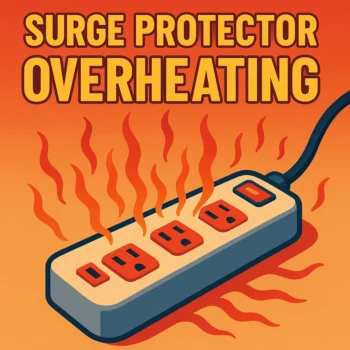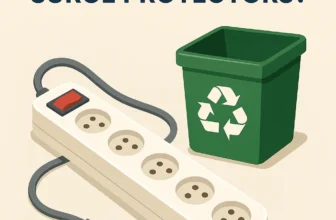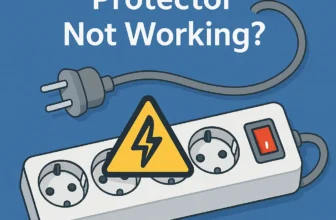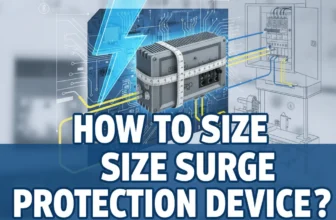
Surge protectors, often considered unsung heroes in our home, quietly stand guard against the relentless onslaught of power surges and voltage fluctuations, shielding our valuable devices from potential harm. These unassuming surge protectors are not immune to their own set of challenges. One such challenge is the phenomenon of overheating.
Although surge protector overheating might be a common occurrence, it is very important to be aware of some of the dangers, signs, and causes, and how we can prevent it from happening.
So, next time you plug in your electronics, remember to thank the unsung hero quietly standing guard in the background – your trusty surge protector, which shields your valuable devices from potential harm caused by voltage fluctuations.
Causes of Surge Protector Overheating
The primary reasons for overheating are overloading, inadequate ventilation, the use of low-quality materials and construction, and age. Understanding the causes can help avoid potential disasters, extend the life of your device, and ensure the optimal operation of your electronic equipment.
Overloading
Surge protectors, despite their relative strength, are not invincible – they have their limits. Overloading is one of the most common causes of an overheated surge protector. This happens when the number of devices connected to a surge protector or the cumulative energy they consume exceeds the surge protector’s capacity. For instance, if multiple heavy appliances like refrigerators, air conditioners, heaters, or ovens are plugged into a single surge protector, it can quickly lead to overheating.
Overloading not only raises the risk of overheating but also deteriorates the surge protector’s performance and increases the probability of an electrical fire.
Inadequate Ventilation
Just like any electronic device, surge protectors generate heat through operational friction. However, if the surge protector is not exposed to an open environment or is kept in an enclosed space with little or no airflow, it cannot release this heat efficiently. This lack of adequate ventilation can potentially lead to heat buildup and subsequent overheating.
Storing a surge protector in an enclosed or cramped space or covering it with a rug or curtains can suffocate the unit and significantly increase its chances of overheating.
Low-Quality Material and Construction
The propensity for a surge protector to overheat is significantly influenced by the caliber of the materials employed in its construction, in conjunction with the overall quality of its design and assembly. Surge protectors made of low-quality materials or those that are poorly constructed usually cannot withstand high electrical currents and tend to overheat quickly. Also, surge protectors without the necessary safety features, such as ventilation openings, heat-resistant casing, or overload protection, have a higher risk of overheating.
Always invest in a quality surge protector from a reputable brand if budget is not an issue.
Age
With time, all things wear out, and surge protectors are no exception. As surge protectors age, their components may degrade, reducing their ability to handle power surges effectively, and might lead to increased heat production. Over time, continual heat exposure can warp or damage internal components, increasing the likelihood that the surge protector will overheat.
If your surge protector has been in use for an extended period, particularly if it has experienced multiple voltage spikes or displays any physical deterioration, it would be prudent to contemplate acquiring a replacement unit.
It’s also recommended to immediately replace any surge protector that has experienced a large power surge or lightning strike.
Dangers of Overheated Surge Protectors
An overheated surge protector is not just a simple inconvenience; it can lead to serious consequences if not properly addressed. This can range from electrical shorts and fires, to damage to connected devices and even power failures.
Electrical Shorts and Fires
One of the imminent dangers of an overheated surge protector is the risk of electrical shorts and fires. When a surge protector overheats, it can cause the protective casing to melt, potentially exposing the internal wiring. This can lead to electrical shorts, sparking, and in the worst scenarios, a fire.
According to the National Fire Protection Association, electrical fires are a leading cause of home fires in the United States, many of which can be linked back to faulty or overheated surge protectors.
Damage to Connected Devices
An overheated surge protector can also cause damage to any devices connected to it. A surge protector’s primary role is to safeguard electronic devices from voltage spikes by limiting the voltage supplied to an electric device by either blocking or shorting to ground any unwanted voltages above a safe threshold. If a surge protector overheats, the capabilities of this defense mechanism may be compromised and apply excess voltage to the connected devices.
This can lead to serious damage or destroy the connected devices.
Power Failure
Overheating can cause significant damage to the surge protector, rendering it unusable. If the surge protector fails, it can result in a total power outage for any devices connected to it. This would be particularly problematic for any critical equipment that relies on a steady power supply to function. In office scenarios, this can lead to the loss of unsaved work or technical malfunctions. This could also affect important home devices such as refrigerators or medical equipment. It’s essential to be aware of the potential risks of overheated surge protectors to minimize any damage.
If you notice your surge protector is overheating, unplug any devices and replace it immediately. Remain vigilant and preventative to avoid these risks altogether, remembering that one’s safety should always be the priority.
Signs That Your Surge Protector is Overheating
If your surge protector is overheating, there are several indicators you can look out for. By being observant, you can prevent potential problems before they escalate.
Physical Deformities
A clear sign that your surge protector is overheating is visible physical deformities. These might include a melted or bent casing, warping, or other aberrations that were not present when the surge protector was new. The heat can cause the plastic casing to distort or even melt, which is a clear danger signal.
Unusual Smells
Another sign to be on the lookout for is unusual smells emanating from the surge protector. Overheating can cause a burning smell, similar to that of burning plastic or electronic components. This scent is a clear warning that your surge protector is overheating and should be replaced immediately.
Avoid touching the surge protector if possible, as the internal components may be hot enough to cause injury.
Discoloration
Discoloration of the surge protector is a less obvious sign but equally concerning. This could appear as browning or blackening spots on the protective case, especially around the socket areas.
The discoloration is usually a result of excessive overheating and an indication of potential fire hazards.
Decreased Functionality
The last sign, albeit subtle, is reduced functionality. If you have devices plugged into the surge protector and there are occurrences of intermittent power or the device isn’t working properly, this could be a sign that your surge protector is overheating. Never ignore these signs, as they may indicate that the surge protector has lost its ability to regulate the power supply adequately.
These signs require immediate attention to prevent further damage to your devices or potential fire hazards. If you suspect that your surge protector is overheating, the safest option is always to unplug all devices and replace the surge protector.
Regular checks and preventive maintenance can help keep your devices safe and extend the life of your surge protector.
Prevention of Surge Protector Overheating
Overheating of a surge protector poses a serious risk to both the protector itself and the appliances and devices plugged into it. Therefore, preventive measures are necessary to ensure safety. Here are some steps you can take to prevent surge protector overheating.
Avoid Overloading
One of the main causes of overheating in surge protectors is overloading. This occurs when you plug too many high-powered devices or appliances into a single surge protector. The high demand can lead to circuitry overloading and eventually heating the system.
So, it’s important to understand the overall capacity of your surge protector and never plug-in devices that, taken together, exceed that capacity.
Ensure Good Ventilation/Proper Placement
Like any electronic device, surge protectors need to ventilate heat to function properly. Ensure your surge protector is placed in a well-ventilated area and kept away from materials that can easily catch fire, such as paper, fabric, or flammable chemicals. Placing it on cool, non-carpeted surfaces helps with heat dissipation.
Invest in High-Quality Surge Protectors
Quality should always be a top priority when selecting a surge protector. High-quality surge protectors feature enhanced built-in components that help mitigate overheating risks. Look for ones that are made of flame-resistant materials and have thermal fuses.
These may cost a little more, but it’s a worthy investment for the additional safety and longevity.
Regular Inspection and Maintenance
Regular inspection and maintenance play a crucial role in preventing overheating. Check for any signs of overheating mentioned earlier, such as physical deformities, unusual odors, discoloration, and reduced functionality. It’s also a good idea to clean your surge protector (make sure it’s unplugged and dry before plugging it back) to remove dust that can build up and cause heat retention.
Consider Energy Saving Techniques to Reduce Load
Employing energy-saving techniques can also help prevent overheating. This involves not only unplugging devices when not in use but also consciously reducing the number of devices connected to a single surge protector. By doing so, you can significantly reduce the overall electrical load and thereby minimize the risk of overheating.
You might also consider investing in more energy-efficient appliances and devices to load-balance your power consumption.
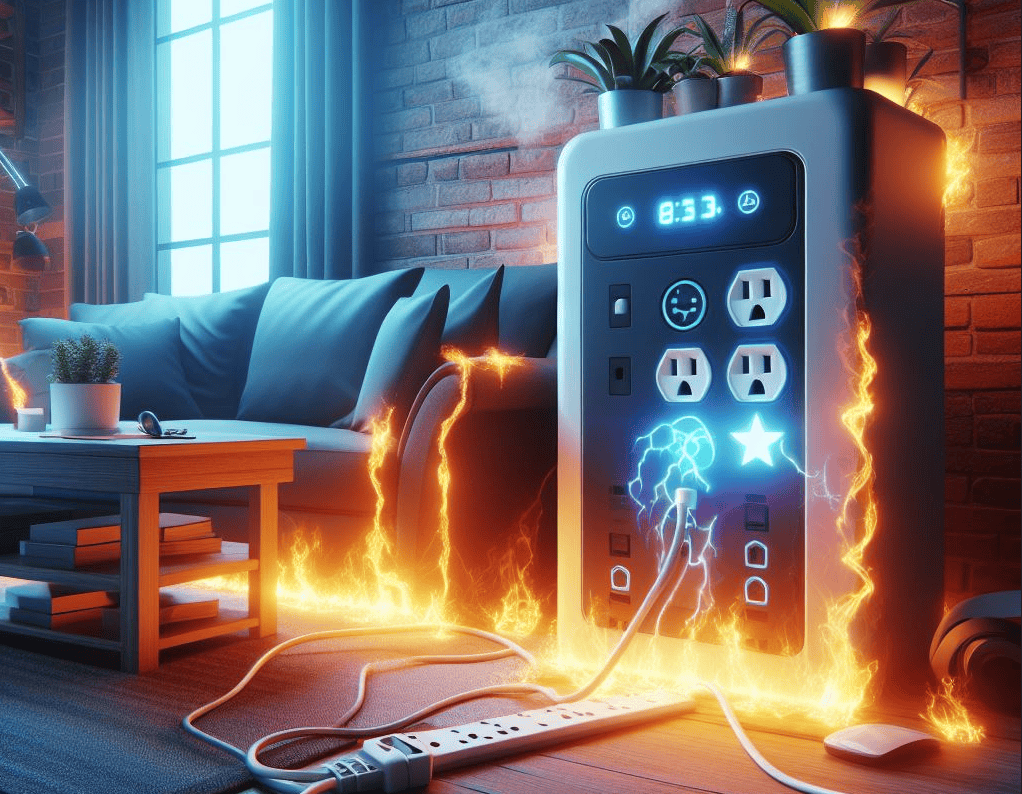
What to Do if Your Surge Protector Overheats?
Handling an overheated surge protector can be treacherous, and thus, it’s crucial to know the appropriate steps to take in such a situation.
Immediate Actions
If you find your surge protector overheating, unplug all the devices immediately. Then safely disconnect the surge protector from the power source.
Allow it to cool completely before you handle it. Doing so will eliminate the immediate danger and the risk of electric shock during handling. Check the surge protector for any visible damage. Signs of serious overheating include melted or twisted plastic, discoloration, and a burnt smell. If you observe any of these signs, it’s best to discard the protector, as it might be risky to reuse it.
Never attempt to repair a surge protector on your own, as this can be dangerous and often voids the warranty.
Long-Term Solutions
If overheating becomes a recurring issue with your surge protectors, it’s time to reassess the quality of your equipment and your usage habits. Consider investing in a high-quality, certified surge protector, which offers enhanced protection against overloads, thereby reducing the likelihood of overheating. Also, review the total power being drawn from the protector.
Avoid plugging high-energy-consuming devices into the same protector. Distributing these across multiple surge protectors can help prevent overload and subsequent overheating.
Summing up…
Overheating of surge protectors typically occurs due to overloading and inadequate ventilation. Preventing surge protector overheating calls for constant surveillance and upkeep. Regular maintenance and inspection are vital to spot early signs of overheating – this includes visually checking the surge protector for deformities and unusual smells, and physically for temperature.
It’s equally important to review our usage practices and energy consumption to ensure we’re not inadvertently causing the surge protector to exceed its capacity. Through combined preventive and protective measures, we can ensure the longevity and safety of our surge protector.
FAQs
Why does my surge protector get hot?
Surge protectors can get hot due to various reasons, including:
1. Overloading: If you plug too many high-powered devices into a surge protector, it can lead to overheating as the protector struggles to handle the excess load.
2. Faulty Surge Protector: A surge protector that is damaged internally or has worn-out components might generate more heat than usual.
3. Poor Ventilation: Inadequate airflow around the surge protector can restrict heat dissipation, causing it to get hot.
4. Power Surges: Continuous or frequent power surges can cause the surge protector to get hot as it tries to suppress the extra voltage.
How hot is too hot for a surge protector?
While surge protectors can get warm during normal operation, excessive heat can indicate a problem. As a general guideline, shut off the power supply immediately if the surge protector feels too hot to touch comfortably.
Is it normal for a surge protector to be warm?
It is normal for a surge protector to generate some heat during operation, especially if it is actively protecting against power surges. However, if the heat levels are excessive or if the surge protector consistently feels warm to the touch, it may indicate a problem that needs attention.
Can an overheating surge protector cause a fire?
Yes, an overheating surge protector can potentially cause a fire if the heat generated is not properly dissipated or if flammable materials are nearby. Overheating can damage the internal components of the surge protector, leading to a short circuit or other electrical issues that may ignite a fire. Try to monitor the temperature of your surge protector and take necessary precautions to prevent overheating and reduce the risk of fire hazards.
By staying informed about surge protector overheating and taking proactive measures to address any potential issues, you can ensure the safety and functionality of your electrical devices and safeguard your home from electrical hazards.

